Monthly Updates on Recent Books in the History of Christianity
To raise awareness of recent books in the history of Christianity, the editorial staff of Church History: Studies in Christianity and Culture highlights each month a list of 10-15 books in diverse periods and geographical regions that we hope will be of interest to our members. We include here below the 43rd monthly list, chosen by our staff, with excerpts from the publishers’ blurbs.

Matteo Al Kalak, Eating God: A History of the Eucharist. 2023
Eating God examines the history of the Eucharist as a means for understanding transformations in society from the late Middle Ages onwards. After an introduction on the sacrament from its origins to the Protestant Reformation, this book considers how it changed the customs and habits of society, on not only behavioural and imaginative levels, but also artistic and figurative level. The author focuses on Counter-Reformation Italy as a laboratory for the whole of Christendom subject to Rome, and reflects on how, even today, the transformations of the modern age are relevant and influence contemporary debate. This book offers an innovative path through the history of a sacrament, with consideration of its impact as an ‘object’ that was used, venerated, eaten, depicted and celebrated far beyond the sphere of liturgical celebration. It will be particularly relevant to those interested in cultural history and the history of Christianity.
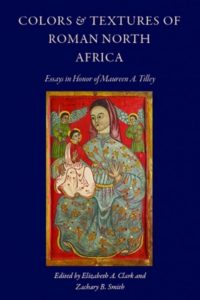
Elizabeth A. Clark and Zachary B. Smith, eds. Colors and Textures of Roman North Africa. Essays in Memory of Maureen A. Tilley. 2024
Catholic University of America Press
This book serves two purposes: first, it celebrates the career of the late Maureen Tilley; second, it provides a "state of the field" look at some of the latest scholarship on Christian North Africa in late antiquity. The chapters, written by both senior scholars and the next generation of North African researchers, fills gaps in some of our understandings of the colorful people, places, and disputes that arose in the unique environment of Christian North Africa. The book centers around Augustine, Donatist studies, and North African biblical interpretation, representing Tilley’s major areas of interest, while also ensuring coverage of Tertullian (a major figure in the North African church and one of Tilley’s hobbyhorses) and the pilgrimages to North Africa and other places. It contributes to the field(s) by providing new scholarship from some of the biggest names in Christian North Africa studies (Patout Burns, Robin Jensen, Bill Tabbernee, Anthony Dupont, and Allan Fitzgerald) and in Patristic/early Christian studies writ large (Blake Leyerle and Geoffrey Dunn) while demonstrating the new trajectories of Christian North Africa research from early career (Alden Bass) and emerging (Colum Dever) scholars. The editors were Tilley’s dissertation director (the late Liz Clark) and one of her last mentees (Zach Smith), so the entire collection has a meta-view of academic genealogy – knowledge flowing from Tilley’s mentor, through colleagues and mentees, and down through and to the next generation who carry on those legacies.
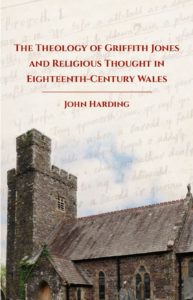
John Harding, The Theology of Griffith Jones and Religious Thought in Eighteenth Century Wales. 2024
The Theology of Griffith Jones and Religious Thought in Eighteenth-Century Wales discusses Griffith Jones’s High Church ministry and theology, which developed into mass evangelism in Wales. It considers his background, life as a parson, preaching in Welsh and educational interests, and his determination to remain within the Church of England. Bishop George Bull’s concerns about evangelism, the influence of the Prayer Book and Continental Pietism, “conversionism,” and the tendency to separatism are also discussed. Jones may not have been an original thinker, but he was an untiring communicator and organizer. There are sections on his catechizing, “baptismal covenant,” and moderate Calvinism, which influenced later Welsh Calvinistic Methodism. Jones’s advocacy of the Welsh language, especially with English donors to his schools, his links with the SPCK, and his collaboration with gentry—especially Sir John Philipps and Bridget Bevan—show the effectiveness with which he managed the growing evangelical movement in Wales.

Andrew B. Gardner, Binkley: A Congregational History. 2024
What makes a Baptist church Baptist? Casual observers might be tempted to stereotype the churches of the American South, but scholar Andrew B. Gardner paints a portrait of one North Carolina congregation that defies easy categorization.
Established in 1958 in the college town of Chapel Hill, North Carolina, the Olin T. Binkley Memorial Baptist Church immediately sought to establish a welcoming religious community—focusing initially on bringing in both Black and White congregants and, as ideas about inclusivity developed, on accepting all people, regardless of identity. By naming itself for a theologically progressive preacher and professor, the fledgling church signaled a perspective unfamiliar to Baptists in the South, which gave the church a radical edge. The church’s first pastor, Robert Seymour, also possessed a progressive vision that resonated with his congregants and pushed them to commit to justice and equality. Soon after its founding, the church strived to challenge inequality in segregated Chapel Hill. Although it remained predominantly White well into the twenty-first century, Binkley evolved to become increasingly aware of issues of gender equality, equity, LGBTQ inclusion, and climate justice. Addressing these issues was Binkley’s way of building God’s kingdom on earth as it is in heaven.
Binkley: A Congregational History tells the story of a single church with a complicated past, demonstrating that, while liberal in heritage, it operated with an unconsciously White, heteronormative worldview that slowly evolved into a distinct expression of faith. The author also draws on scholarship within the broader field of American religious history to position Binkley—with all its complexities, conflicts, and nuances—within the broader context of twentieth-century liberal Protestantism. Perhaps most importantly, Gardner tells the story of a place animated by a vision of Christianity that is often overlooked or drowned out by larger and louder Christian groups. He compellingly shows how this progressive vision of Christianity has shaped Binkley’s commitment to its community and beyond.

Curtis J. Evans, A Theology of Brotherhood: The Federal Council of Churches and the Problem of Race. 2024
A Theology of Brotherhood explores how the national umbrella Christian organization, the Federal Council of Churches, acted as a crucial conduit and organizational force for the dissemination of “progressive” views on race in the first half of the twentieth century.
Drawing on years of archival research, Curtis J. Evans shows that the Council’s theological approach to race, and in particular its anti-lynching campaign, were responsible for meaningful progress in some white Protestant churches on racial issues. The book highlights the contributions that their religious vision made in expanding and propagating a civic nationalist tradition that was grounded in a “universal brotherhood” and belief in the equality of all human beings, over against a racial nationalist ideology that conceived of America in ethno-racial terms.
Evans makes the case that this predominantly white religious organization contributed a distinctive religious voice to visions of a pluralistic democracy, racial and ethnic diversity, and social and political reform. The volume adds a missing voice to the literature on lynching in the early twentieth century, which tends to focus primarily on the NAACP and other secular organizations.
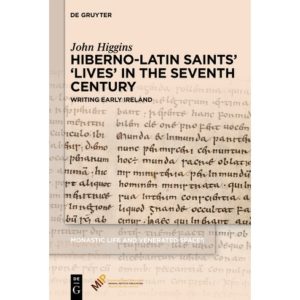
John Higgins, Hiberno-Latin Saints’ ‘Lives’ in the Seventh Century: Writing Early Ireland. 2024
As part of the historicizing corpus of seventh-century Irish writing, the Lives framed the narrative of the early saints as an effective weapon in contemporary political and ecclesiastical conflicts. Cogitosus’s Life of Brigit, Muirchú’s and Tírechán’s accounts of Saint Patrick, and Adomnán’s Life of Columba created the understanding of the history of early Ireland that has endured to this day. How did the writers accomplish this through their literary choices?
The authors of Irish saints’ Lives used the literary form of hagiography (Christian biography), miracle stories, and an elaborate rhetorical style to present the words and actions of their subjects. These Lives created a narrative of early Irish history that supported the political/ecclesiastical elites by showing that their power derived from the actions of their patron saints.

Kristine Wirts, A Peddler’s Tale: Religious Exile and Community in Early Modern Switzerland. 2024
Louisiana State University Press
In 1685, the revocation of the Edict of Nantes made Catholicism the only recognized religion in France and criminalized the practice of Calvinism, throwing the minority Protestant population into crisis. A Peddler’s Tale personifies these events in the story of Jean Giraud, a Protestant merchant-peddler, and his various communities. Drawing on Giraud’s account book; municipal, parish, and consistory records; and death inventories, Kristine Wirts ably reconstructs Giraud’s familial, commercial, and religious circles. She provides a detailed description of the persecution of Giraud and his fellow church members in La Grave, France, as well as their flight across the Alps to Vevey, Switzerland. The town’s residents did not welcome all refugees equally, often expelling Huguenots without social connections or financial resources. Those allowed to stay worked diligently to reestablish their lives and fortunes. Once settled in Vevey, Giraud and his extended family supported themselves by moneylending and peddling books, watch parts, and lace products.
In contrast to past studies on the Huguenot diaspora that often depicted those fleeing France in heroic terms, A Peddler’s Tale exposes the harsh economic realities many exiles faced, as well as the importance of social relationships and the necessity of having financial means to secure passage and sanctuary. Wirts contends that Huguenot refugees who succeeded in obtaining permanent residency in Vevey shared one important element: many derived their livelihood from the burgeoning economic ties and social bonds that emerged with the rise of capitalist markets. A compelling microhistory, A Peddler’s Tale ultimately illustrates the role and power of informal networks in sustaining and fostering early modern communities.
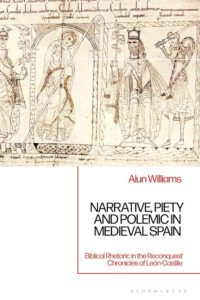
Alun Williams, Narrative, Piety and Polemic in Medieval Spain: Biblical Rhetoric in the Reconquest Chronicles of León-Castile. 2024
This book presents an original perspective on the variety and intensity of biblical narrative and rhetoric in the evolution of history writing in León-Castile during the twelfth and thirteenth centuries. It focuses on six Hispano-Latin chronicles, two of which make unusually overt and emphatic use of biblical texts. Of particular importance is the part played by the influence of exegesis that became integral to scriptural and liturgical influence, both in and beyond monastic institutions.
Alun Williams provides close analysis of the text and comparisons with biblical typology to demonstrate how these historians from the north of Iberia were variously dependent on a growing corpus of patristic and early medieval interpretation to understand and define their world and their sense of place.
Narrative, Piety and Polemic in Medieval Spain sees Williams examine this material as part of a comparative exploration of language and religious allusion, showing how the authors used these biblical-liturgical elements to convey historical context, purpose and interpretation.

Francesca Norman, Henry Longueville Mansel: Victorian Theology, Philosophy, and Politics. 2023
Henry Longueville Mansel (1820-1871), Anglican theologian and philosopher, has wrongly been remembered as a Kantian agnostic whose ideas led to those of Herbert Spencer. Francesca Norman’s book provides a thorough revisioning of Mansel’s theology in context and reveals the personal basis of Spencer’s animus towards Mansel. Mansel is revealed as an orthodox Anglican theistic personalist whose ideas inspired Newman to write his Grammar of Assent. Located in context, Mansel’s personal connections with leading Tory figures such as Lord Carnarvon and Benjamin Disraeli are explored. Key controversies with Frederick Denison Maurice and John Stuart Mill are interpreted with reference to the party political elections of 1859 and 1865. Norman offers a vital vision of nineteenth-century theology, philosophy, and politics.
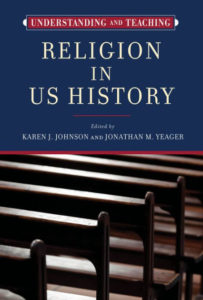
Karen K. Johnson and Jonathan M. Yeager, Understanding and Teaching Religion in U.S. History, 2024
Religion is deeply embedded in American history, and one cannot understand American history’s broad dynamics without accounting for it. Without detailing the history of religions, teachers cannot properly explain key themes in US survey courses, such as politics, social dynamics, immigration and colonization, gender, race, or class. From early Native American beliefs and practices, to European explorations of the New World, to the most recent presidential elections, religion has been a significant feature of the American story. In Understanding and Teaching Religion in US History, a diverse group of eminent historians and history teachers provide a practical tool for teachers looking to improve history instruction at the upper-level secondary and undergraduate level.
This book offers a breadth of voices and approaches to teaching this crucial part of US history. Religion can be a delicate topic, especially in public education, and many students and teachers bring strongly held views and identities to their understanding of the past. The editors and contributors aim to help the reader see religion in fresh ways, to present sources and perspectives that may be unfamiliar, and to suggest practical interventions in the classroom that teachers can use immediately.
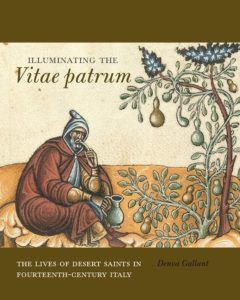
Denva Gallant, Illuminating the Vitae patrum: The Lives of Desert Saints in Fourteenth-Century Italy. 2024
Pennsylvania State University Press
During the fourteenth century in Western Europe, there was a growing interest in imitating the practices of a group of hermits known as the Desert Fathers and Mothers. Laypeople and religious alike learned about their rituals not only through readings from the Vitae patrum (Lives of the Desert Fathers) and sermons but also through the images that brought their stories to life.
In this volume, Denva Gallant examines the Morgan Library’s richly illustrated manuscript of the Vitae patrum (MS M.626), whose extraordinary artworks witness the rise of the eremitic ideal and its impact on the visual culture of late medieval Italy. Drawing upon scholarship on the history of psychology, eastern monasticism, gender, and hagiography, Gallant deepens our understanding of the centrality of the Desert Fathers and Mothers to late medieval piety. She provides important insights into the role of images in making the practices of the desert saints both compelling and accessible to fourteenth-century city dwellers, who were just beginning to cultivate the habit of private devotion on a wide scale.
By focusing on the most extensively illuminated manuscript of the Vitae patrum to emerge during the trecento, this book sheds new light on the ways in which images communicated and reinforced modes of piety. It will be of interest to art historians, religious historians, and students focusing on this period in Italian history.
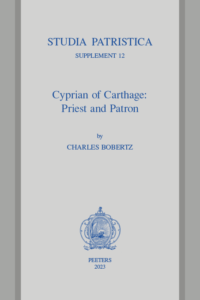
Charles Bobertz, Cyprian of Carthage: Priest and Patron. 2024
Cyprian of Carthage: Priest and Patron places the election of Cyprian and his actions as bishop squarely within the social and political expectations surrounding the giving and receiving of patronage in third-century Roman Africa. Beginning with a description of patronage and patron-client relationships available to us from inscriptional and literary sources, the study moves to better understand the social context surrounding the emergence of episcopal authority at a crucial stage in the emergence of the institutional Christian church. Cyprian's understanding of the singular authority of the bishop, that the bishop is the Church, developed within the ancient social expectations of patrons and clients. And it is this understanding that chartered the course for what became the episcopal Church of the fourth and fifth century Roman Empire. It is also an understanding that continues to have great influence on the development of models of ecclesial authority and governance right up to the present day.
Finally, for staying up-to-date on the latest titles in all fields, we recommend regularly perusing New Books Network and its "New Books in Christian Studies” page. These pages are updated regularly.
